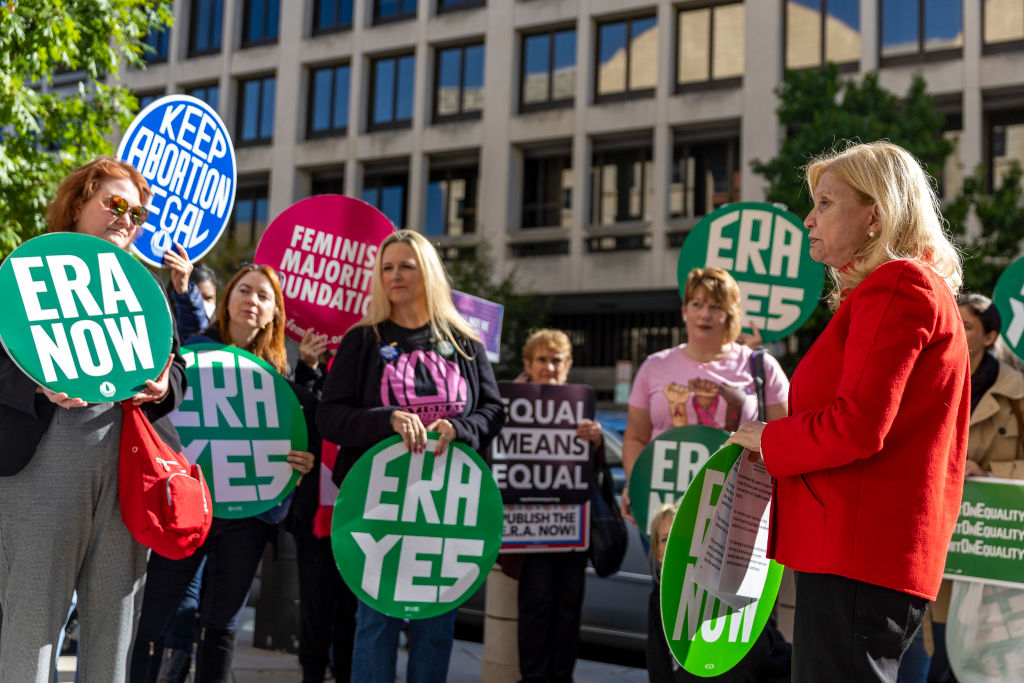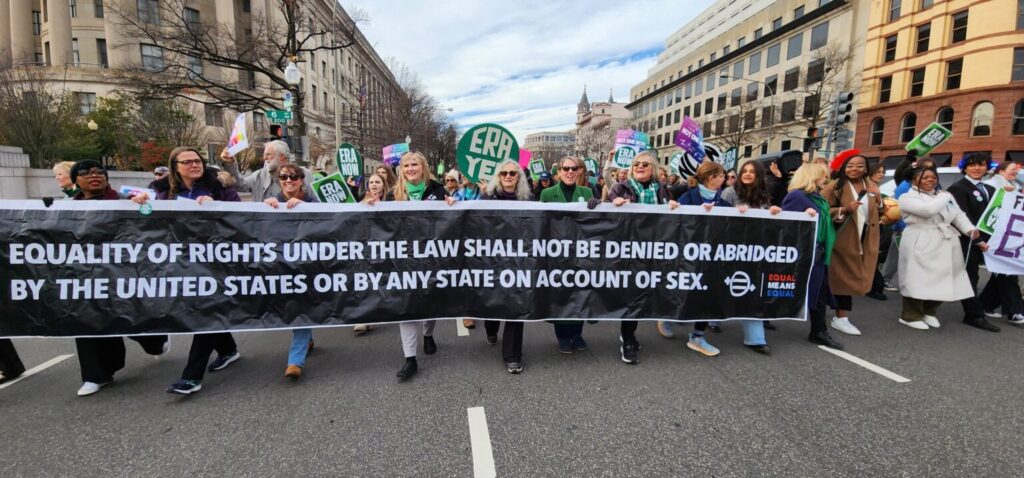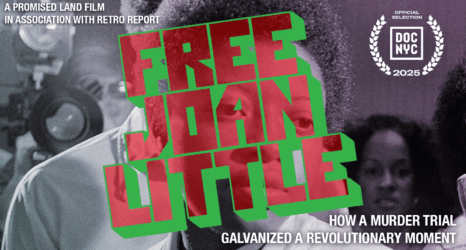
The “ERA YES” buttons are green—the color of money—signaling the huge role that economic issues play in the ERA. But in a world where hard-won rights to freedom are being rolled back, the Equal Rights Amendment means much more than equal pay, said Lisa Sales, president of Virginia National Organization for Women (NOW).
The iconic green buttons were worn by many in the crowd at the Radical Optimism Conference on Jan. 26, hosted by former U.S. Rep Carolyn Maloney and now-president of New York state NOW, at the Hunter College Roosevelt House in New York City. Political activists from around the state rallied for recognition of the federal ERA, made plans for securing a New York state constitutional amendment, plotted strategies for the 2024 elections and committed themselves to showing strong support by recruiting signers for the national ERA petition, Sign4ERA.org.

National Pathway for Adding Gender Equality to the U.S. Constitution
“In 2024, women’s rights will be on the ballot,” said Eleanor Smeal, president of the Feminist Majority and longtime leader in the fight for the ERA. She explained that putting the ERA into the Constitution could permanently guarantee reproductive rights in all states.
The ERA passed Congress in 1972 with the needed two-thirds vote of the U.S. House and Senate. The required three-fourths of the state legislatures then ratified the ERA when Virginia became the 38th state in 2020.
Now ERA leaders in Congress are working to pass resolutions to recognize the ERA and for the archivist to publish it as the 28th Amendment.
In January 2023, at the beginning of the new congressional session, identical joint resolutions were introduced in both the House (HJ Res 25) and in the Senate (SJ Res 4) that “notwithstanding any time limit” in the preamble, the ERA is valid having been ratified by 38 states.
Three months later, in the Senate, the ERA fell short of the 60 votes needed to override a likely filibuster with a vote of 51 “yes” and 47 “no”—with all Democrats and Independents voting for the ERA, joined by two Republicans, Sens. Susan Collins of Maine and Lisa Murkowski of Alaska. Sen. Dianne Feinstein was unable to vote due to absence for health, and Senate Majority Leader Chuck Schumer (D-N.Y.) switched his vote to “no” so that there would be additional opportunities to vote on the ERA later this year.
If another Senate ERA vote occurs in this congressional session, the ERA would have the support of 53 senators—falling short of the 60 needed to stop a filibuster but enough should Senate rules be changed.
In the House of Representatives, ERA leaders are pursuing a discharge petition that requires sign-on by 218 members; the discharge petition currently has more than 200 signatories. It would require the speaker to hold a vote and bypass committee hearings and approvals. This was the same strategy used by former U.S. Rep. Martha Griffiths (D-Mich.) to bring the ERA to the floor in 1972.
If the Equal Rights Amendment weren’t so important, they wouldn’t be fighting so hard to keep it from us.
Zakiya Thomas, president and CEO of the ERA Coalition
ERA advocates are now pushing members of both the House and Senate to support the joint resolutions and discharge petition while making it a priority in the 2024 elections.
New York’s State ERA
In New York, advocates are working to add an ERA to the state Constitution. The needed first step occurred on Jan. 24 when the New York legislature passed its own Equal Rights Amendment that puts the ERA before voters in November.
“It’s the 21st century. We’re New York. We’re supposed to do it best and first. Let’s just go for a revision of an outdated Constitution,” said New York state Senator Liz Krueger, sponsor of the amendment who spoke at the Radical Optimism Conference.
The proposed amendment provides that “no person shall be denied the equal protection of the laws.” And further that “no person shall, because of race, color, ethnicity, national origin, age, disability, creed, religion or sex, including sexual orientation, gender identity or expression, pregnancy, pregnancy outcomes, reproductive healthcare and autonomy, be subjected to any discrimination in their civil rights by any other person or by any firm, corporation, or institution, or by the state or any agency or subdivision of the state.”
“In this day and age, we need to provide protection and anti-discrimination language at a broad level,” said Rep. Rebecca Seawright, who also spoke.
Continuing the Fight in Congress and During the 2024 Elections
Celinda Lake, president of Lake Research Partners, reported nationwide data from a poll conducted for Ms. and Feminist Majority Foundation in September 2023. Abortion rights and the Equal Rights Amendment hold great salience in the 2024 election among voters, according to Lake’s data:
- Seventy-four percent of voters support a person’s right to make their own reproductive decisions, including abortion, contraception and continuing a pregnancy.
- Threats to democracy and abortion/women’s rights were the second and third top-of-mind issues for all voters after inflation.
- Fifty-nine percent of voters consider themselves feminists.
- Voters are overwhelmingly in support of the ERA: It is a universal value for Democrats and very strong with Independents, especially Independent women voters.
“Without a fundamental right to equality, we won’t have an equal society,” said Zakiya Thomas, president and CEO of the ERA Coalition and the Fund for Women’s Equality. Thomas recounted the significant value of the diversity and equal economic opportunities the ERA could bring about.
“If equality and the Equal Rights Amendment, in particular, weren’t so important, they wouldn’t be fighting so hard to keep it from us,” said Thomas––referencing that the forces fighting against reproductive and LGBTQ+ rights, transgender rights in particular, are the same and see liberation as a threat.
Aarush Santoshi, an incoming first-year student at Stanford University and the national federal policy director of Generation Ratify, now called The Young Feminist Party, expanded the conversation, emphasizing the ERA is intersectional.
Young people have the most to gain and the most to lose from the ERA—and they are the past, present and future of the amendment, said Santoshi.
“The ERA would protect reproductive rights because it protects against discrimination based on sex, including abortion access, the right to privacy, and the right to the decision over one’s body,” said Smeal.

Bella Ramírez, one of the students at Hunter College who helped launch Sign4ERA.org, fears the United States is at risk of turning into an autocracy, as it appears the government can ignore public preference when it takes actions that erode human rights, such as the overturning of Roe v. Wade. She believes the ERA is one of the most powerful tools against the rise of autocracy because it strengthens democracy.
“A true democracy relies on equality, and right now, we don’t have that,” she said. What the younger generation has to gain from the ERA is “nothing less than democracy itself. “
“Once the ERA is in the Constitution, it is a bedrock of protection,” said Maloney, who asks herself every day why it is so hard to have these 24 words enshrined into the United States Constitution:
Equality of rights under the law shall not be denied or abridged by the United States or by any state on account of sex.
“We hope for a future where you do not have to define yourself worthy of protection, you just are,” said Santoshi.
Take Action for the ERA
- Sign the ERA petition and share.
- Make sure you’re registered to vote and vote in the 2024 elections.
- Join the effort to get out the vote in your community.
- Make the ERA a topic of conversation in your local government.
Care about women’s equality? We do too. Let Ms. keep you up to date with our daily + weekly newsletters. (Or go back to the “ERA Is Essential to Democracy” media collection.)
U.S. democracy is at a dangerous inflection point—from the demise of abortion rights, to a lack of pay equity and parental leave, to skyrocketing maternal mortality, and attacks on trans health. Left unchecked, these crises will lead to wider gaps in political participation and representation. For 50 years, Ms. has been forging feminist journalism—reporting, rebelling and truth-telling from the front-lines, championing the Equal Rights Amendment, and centering the stories of those most impacted. With all that’s at stake for equality, we are redoubling our commitment for the next 50 years. In turn, we need your help, Support Ms. today with a donation—any amount that is meaningful to you. For as little as $5 each month, you’ll receive the print magazine along with our e-newsletters, action alerts, and invitations to Ms. Studios events and podcasts. We are grateful for your loyalty and ferocity.






